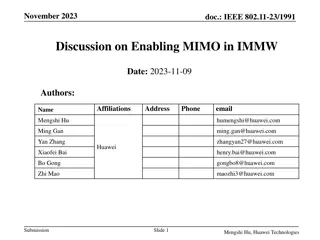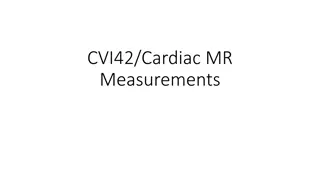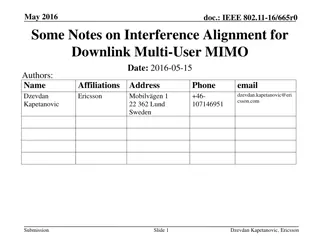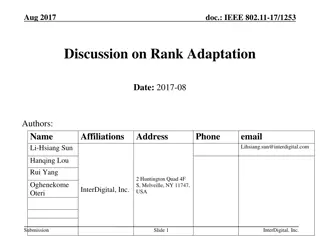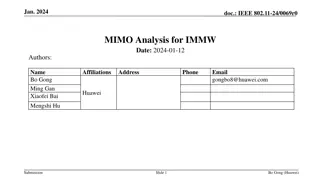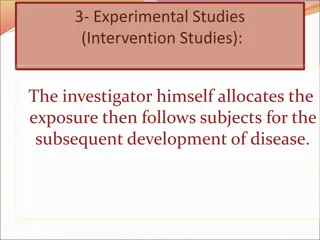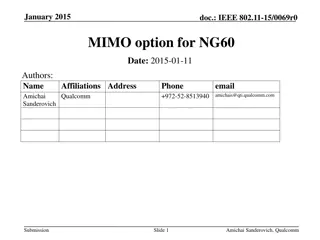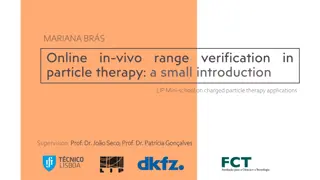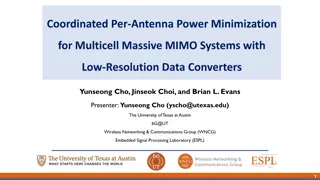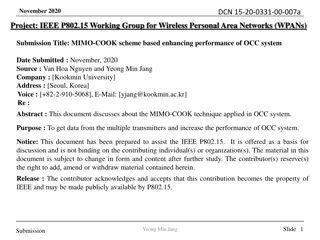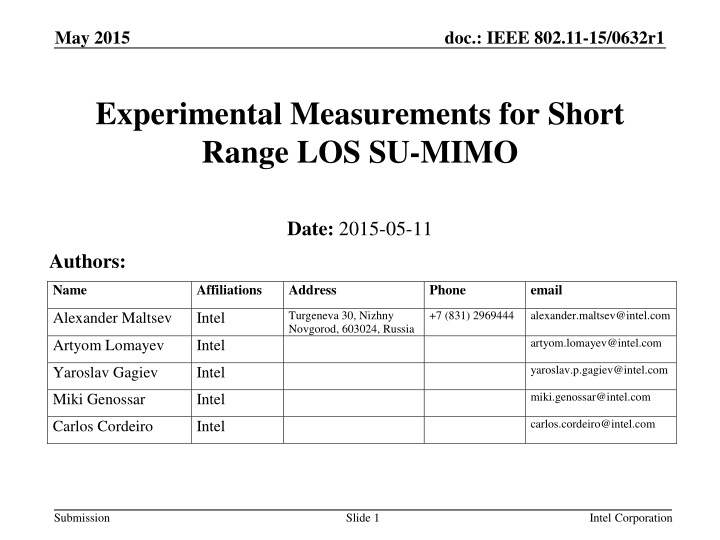
Experimental Measurements for Short Range LOS SU-MIMO System
This document presents experimental measurements for a Line-of-Sight (LOS) short-range 2x2 Single-User Multiple-Input Multiple-Output (SU-MIMO) system. The results highlight the impact of factors such as phase difference, cross links, antenna separation, and polarization on the system's performance. Potential usage models and LOS MIMO configurations are also discussed, offering insights into the proposed system's applications and setups for scenarios such as device-to-device communication and wireless docking.
Download Presentation

Please find below an Image/Link to download the presentation.
The content on the website is provided AS IS for your information and personal use only. It may not be sold, licensed, or shared on other websites without obtaining consent from the author. If you encounter any issues during the download, it is possible that the publisher has removed the file from their server.
You are allowed to download the files provided on this website for personal or commercial use, subject to the condition that they are used lawfully. All files are the property of their respective owners.
The content on the website is provided AS IS for your information and personal use only. It may not be sold, licensed, or shared on other websites without obtaining consent from the author.
E N D
Presentation Transcript
May 2015 doc.: IEEE 802.11-15/0632r1 Experimental Measurements for Short Range LOS SU-MIMO Date: 2015-05-11 Authors: Name Affiliations Address Phone email +7 (831) 2969444 Turgeneva 30, Nizhny Novgorod, 603024, Russia alexander.maltsev@intel.com Alexander Maltsev Intel artyom.lomayev@intel.com Artyom Lomayev Intel yaroslav.p.gagiev@intel.com Yaroslav Gagiev Intel miki.genossar@intel.com Miki Genossar Intel carlos.cordeiro@intel.com Carlos Cordeiro Intel Submission Slide 1 Intel Corporation
May 2015 doc.: IEEE 802.11-15/0632r1 Abstract This contribution presents the results of experimental measurements for the LOS short range 2x2 SU-MIMO system, [1]. As it was shown in [2] for particular example of 2x2 LOS MIMO configuration the Shannon capacity depends on the phase difference between channel coefficients and attenuation factor of the cross links. However it was shown that the dependence on phase difference is not prominent if the power of cross links is small enough comparing to the power of the direct links. In this work the results of non-coherent channel measurements are provided. In particular the power of the direct and cross links is measured and the impact of spatial antennas separation and antennas cross polarization is investigated. The previous channel measurement results (IEEE 802.11ad) obtained for the larger distances and reflected paths can be found in references [3], [4]. Submission Slide 2 Intel Corporation
May 2015 doc.: IEEE 802.11-15/0632r1 Usage Models Description The LOS SU-MIMO is proposed to be used for different usage models scenarios, [5], [6]: Sync-and-go kiosk, digital content downloading; Device-to-device (D2D) short range communication, tablet to laptop, handheld to laptop, laptop to laptop; Wireless docking, connection of the laptop to external monitor and other peripherals. The distance of interest can be from ~10 - 20 cm and up to ~2 m; Sync-and-go kiosk Wireless docking D2D communication Submission Slide 3 Intel Corporation
May 2015 doc.: IEEE 802.11-15/0632r1 LOS MIMO Configurations Figure below shows two LOS MIMO configurations investigated in the experiment. Configuration #1: Both devices have two Phased Antenna Array (PAAs), which can be separated by d = 10 30 cm and have vertical polarizations (V). It is assumed that antennas are mounted in the corners of the laptop s lid or in the corners of the tablet device. Configuration #2: Both devices have single PAA, but it is divided into two subarrays whose elements have different polarization types, i.e. vertical (V) or horizontal (H). This configuration may be viable for small factor handheld devices where spatial separation of antennas is not possible. Array is divided into two subarrays with different polarizations d d Device #2 Distance between devices - D Distance between devices - D d distance between PAAs E E D distance between devices Vertical E vector orientation V V V H Horizontal E vector orientation E E Device #1 d d (1) Spatial separation d = 10 30 cm (2) Cross polarization d = 0 Submission Slide 4 Intel Corporation
May 2015 doc.: IEEE 802.11-15/0632r1 Measurement Setup Description Configuration #1 antennas spatial separation: Measurements were done in the conference room, TX and RX devices are placed on the table. Both TX Phased Antenna Arrays (PAAs) and RX PAAs have vertical polarization and the same geometry of 2 x 8 elements. PAAs are placed at the height of 18 cm above the table. Distance between the geometrical centers of TX/RX PAAs: d = 10, 20, and 30 cm. Distance between TX and RX devices: D = 20 200 cm, with discrete step = 20 cm. Measurements were done after application of TXSS beamforming, assuming that TX PAA 1 makes beamforming with RX PAA 1 and TX PAA 2 makes beamforming with RX PAA 2. Both links are trained independently. Static device Moving device TX/RX PAA 1 RX PAA 1 TX PAA 1 Direct link H11 d = 10 30 cm RX PAA 2 TX PAA 2 E TX/RX PAA 2 18 cm Interfered link H21 18 cm E 0 200 cm Y 30 cm X Submission Slide 5 Intel Corporation
May 2015 doc.: IEEE 802.11-15/0632r1 Measurement Setup Description (Cont d) Configuration #2 cross polarization: The TX PAA uses for transmission subarray of 4 elements and RX PAA uses for reception only 1 omni element of the array. PAAs are placed at the height of 18 cm above the table. The TX PAA has vertical (V) polarization and RX PAA omni element can have vertical (V) or horizontal (H) polarization, distance between TX and RX devices can be D = 20 200 cm, with step = 20 cm; RX one omni element TX subarray of 4 elements E E 18 cm 18 cm Vertical (V) V or H 0 200 cm Y Static device Moving device Submission Slide 6 Intel Corporation
May 2015 doc.: IEEE 802.11-15/0632r1 Measured Signal Characteristics To set up directional link Transmit Sector Sweep (TXSS) beamforming protocol was applied. The following signal characteristics were measured: Received Signal Strength Indicator (RSSI), which is actually a received power in the 2.16 GHz signal bandwidth, mean RSSI was estimated over 105 packet transmissions. Channel impulse response @ 2.64 GHz sample rate for channel coefficients in the direct H11 and interfered link H21. Channel measurements were done non-coherently, i.e. first channel impulse response was measured for link H11 and then for H21 (not simultaneously). Submission Slide 7 Intel Corporation
May 2015 doc.: IEEE 802.11-15/0632r1 Antennas Spatial Separation Figure shows measured Radiation Pattern (RP) for broadside direction (blue line) for 2x8 array and its comparison to the theoretical one (red line) calculated for array with /2 elements spacing. Both curves are plotted for elevation angle equal to 00. Half Power Beamwidth (HPBW) is equal to ~ 14.00. First null corresponds to the ~0.25 rad or ~14.30. Theoretical RP is defined by the following equation: 2 ~ 2 kd Comparison of measured and theoretical radiation patterns for 2x8 /2 array First null of radiation pattern 1 ( ) 2 sin sin N kd x x ( ) G 1 ( ) sin sin x 2 where Nx = 8, dx = /2, azimuth angle. Submission Slide 8 Intel Corporation
May 2015 doc.: IEEE 802.11-15/0632r1 Antennas Spatial Separation (Cont d) The received power for the direct link H11 can be theoretically predicted applying Friis equation: ( ) D P 11 log 20 ~ ( ) D 10 The received power of the interfered link H21 can be theoretically calculated as follows: ( ) ( ( ) ) ( ( ) ) , ~ 20 log 20 log / cos P D arctan d G D 21 10 10 ( ) = / d D where G( ) is PAA gain introduced at the previous slide, d is the PAAs separation distance, D is the distance between devices. Submission Slide 9 Intel Corporation
May 2015 doc.: IEEE 802.11-15/0632r1 Antennas Spatial Separation (Cont d) RSSI Measurements Figure shows dependence of measured mean RSSI vs. distance D (solid lines) for direct link H11 and interfered link H21 for different antennas spatial separation equal to 10, 20, and 30 cm. RSSI is plotted in dB scale relatively to the point with maximum power corresponding to the direct link and D = 20 cm. This reference level is applied to be equal to 0 dB. As it can be seen from the graph, antennas separation by d = 30 cm (pink curve) creates the power difference for direct H11 and interfered link H21 15.0 dB for the distances up to 2 m. Dashed lines correspond to the theoretical dependences P11(D) and P21(D,d) introduced at the previous slides. First null of radiation pattern Submission Slide 10 Intel Corporation
May 2015 doc.: IEEE 802.11-15/0632r1 Antennas Cross Polarization RSSI Measurements Figure shows measured dependence of mean RSSI vs. distance D for TX V RX V and TX V RX H polarization configurations. RSSI is plotted in dB scale relatively to the reference point (assigned to 0 dB) with maximum power corresponding to the direct link and D = 20 cm. The cross polarization factor (X-pol) does not depend on the distance and is equal to 23.0 24.0 dB. Submission Slide 11 Intel Corporation
May 2015 doc.: IEEE 802.11-15/0632r1 Conclusions This work presents the results of non-coherent channel measurements for the LOS short range SU-MIMO system. Two practical configurations for 2x2 MIMO scheme exploiting antennas spatial separation and polarization discrimination were experimentally investigated. It was shown that antennas spatial separation by 30 cm creates the difference in the direct and interfered links more than 15.0 dB for the distances up to 2 m. Cross polarization factor and therefore links separation for the perfect matching of the TX and RX antennas can achieve ~23.0 24.0 dB. Channel impulse responses measured @ 2.64 GHz sample rate for both direct and interfered links in the LOS conference room environment include one main tap and do not contain any significant reflection taps. Submission Slide 12 Intel Corporation
May 2015 doc.: IEEE 802.11-15/0632r1 References et al., 1. A. Estimation for Indoor Environment, IEEE doc. 11-15/0113r1. A. Tarighat et al., A Framework for MIMO Operation over mmWave Links, IEEE doc. 11-15/0334r0. A. Maltsev et al., Experimental Investigation of 60 GHz WLAN Systems in Office Environment, Journal on Selected Areas in Communications, vol. 27, pp. 1488 - 1499, 2009. A. Maltsev et al., Impact of Polarization Characteristics on 60 GHz Indoor Radio Communication Systems, Antennas and Wireless Propagation Letters, vol. 9, pp. 413 - 416, 2010. C. Cordeiro et al., Next 30+ Gbps WLAN, IEEE doc. 11-14/0606r0. R. Sun et al., NG 60 Use Cases, IEEE doc. 11-15/0328r4. Maltsev mmWave MIMO Link Budget 2. 3. 4. 5. Generation 802.11ad: 6. Submission Slide 13 Intel Corporation







